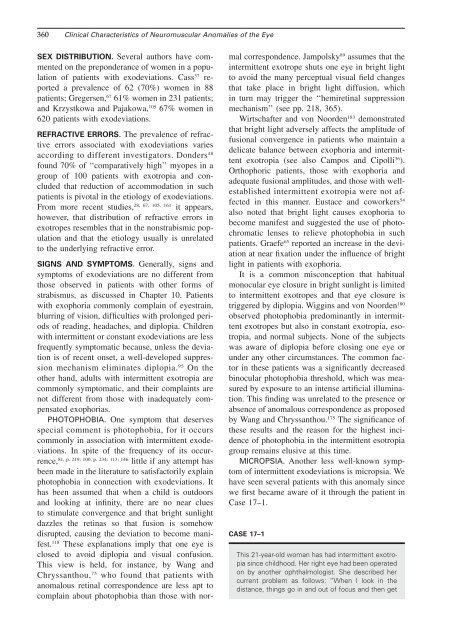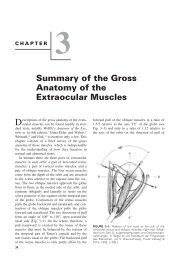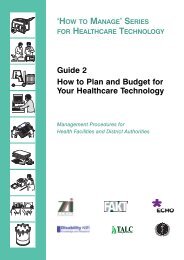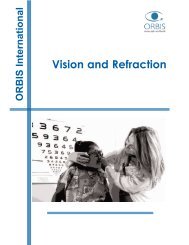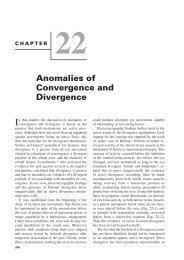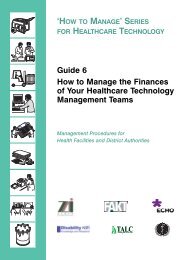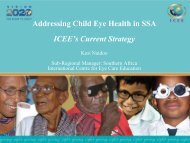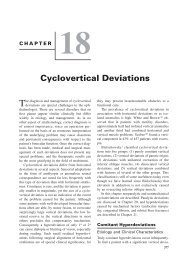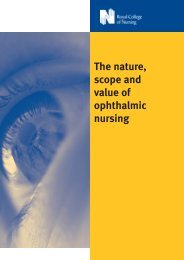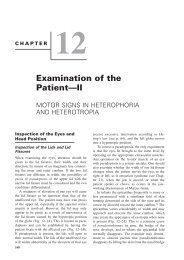Chapter 17: Exodeviations
Chapter 17: Exodeviations
Chapter 17: Exodeviations
Create successful ePaper yourself
Turn your PDF publications into a flip-book with our unique Google optimized e-Paper software.
360 Clinical Characteristics of Neuromuscular Anomalies of the EyeSEX DISTRIBUTION. Several authors have commentedon the preponderance of women in a populationof patients with exodeviations. Cass 37 reporteda prevalence of 62 (70%) women in 88patients; Gregersen, 67 61% women in 231 patients;and Krzystkowa and Pajakowa, 105 67% women in620 patients with exodeviations.REFRACTIVE ERRORS. The prevalence of refractiveerrors associated with exodeviations variesaccording to different investigators. Donders 48found 70% of ‘‘comparatively high’’ myopes in agroup of 100 patients with exotropia and concludedthat reduction of accommodation in suchpatients is pivotal in the etiology of exodeviations.28, 67, 105, 161From more recent studies, it appears,however, that distribution of refractive errors inexotropes resembles that in the nonstrabismic populationand that the etiology usually is unrelatedto the underlying refractive error.SIGNS AND SYMPTOMS. Generally, signs andsymptoms of exodeviations are no different fromthose observed in patients with other forms ofstrabismus, as discussed in <strong>Chapter</strong> 10. Patientswith exophoria commonly complain of eyestrain,blurring of vision, difficulties with prolonged periodsof reading, headaches, and diplopia. Childrenwith intermittent or constant exodeviations are lessfrequently symptomatic because, unless the deviationis of recent onset, a well-developed suppressionmechanism eliminates diplopia. 95 On theother hand, adults with intermittent exotropia arecommonly symptomatic, and their complaints arenot different from those with inadequately compensatedexophorias.PHOTOPHOBIA. One symptom that deservesspecial comment is photophobia, for it occurscommonly in association with intermittent exodeviations.In spite of the frequency of its occurrence,81, p. 219; 100, p. 234; 113; 146 little if any attempt hasbeen made in the literature to satisfactorily explainphotophobia in connection with exodeviations. Ithas been assumed that when a child is outdoorsand looking at infinity, there are no near cluesto stimulate convergence and that bright sunlightdazzles the retinas so that fusion is somehowdisrupted, causing the deviation to become manifest.118 These explanations imply that one eye isclosed to avoid diplopia and visual confusion.This view is held, for instance, by Wang andChryssanthou, 75 who found that patients withanomalous retinal correspondence are less apt tocomplain about photophobia than those with normalcorrespondence. Jampolsky 89 assumes that theintermittent exotrope shuts one eye in bright lightto avoid the many perceptual visual field changesthat take place in bright light diffusion, whichin turn may trigger the ‘‘hemiretinal suppressionmechanism’’ (see pp. 218, 365).Wirtschafter and von Noorden 183 demonstratedthat bright light adversely affects the amplitude offusional convergence in patients who maintain adelicate balance between exophoria and intermittentexotropia (see also Campos and Cipolli 36 ).Orthophoric patients, those with exophoria andadequate fusional amplitudes, and those with wellestablishedintermittent exotropia were not affectedin this manner. Eustace and coworkers 54also noted that bright light causes exophoria tobecome manifest and suggested the use of photochromaticlenses to relieve photophobia in suchpatients. Graefe 65 reported an increase in the deviationat near fixation under the influence of brightlight in patients with exophoria.It is a common misconception that habitualmonocular eye closure in bright sunlight is limitedto intermittent exotropes and that eye closure istriggered by diplopia. Wiggins and von Noorden 180observed photophobia predominantly in intermittentexotropes but also in constant exotropia, esotropia,and normal subjects. None of the subjectswas aware of diplopia before closing one eye orunder any other circumstances. The common factorin these patients was a significantly decreasedbinocular photophobia threshold, which was measuredby exposure to an intense artificial illumination.This finding was unrelated to the presence orabsence of anomalous correspondence as proposedby Wang and Chryssanthou. <strong>17</strong>5 The significance ofthese results and the reason for the highest incidenceof photophobia in the intermittent esotropiagroup remains elusive at this time.MICROPSIA. Another less well-known symptomof intermittent exodeviations is micropsia. Wehave seen several patients with this anomaly sincewe first became aware of it through the patient inCase <strong>17</strong>–1.CASE <strong>17</strong>–1This 21-year-old woman has had intermittent exotropiasince childhood. Her right eye had been operatedon by another ophthalmologist. She described hercurrent problem as follows: ‘‘When I look in thedistance, things go in and out of focus and then get


